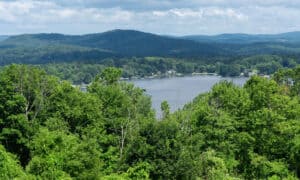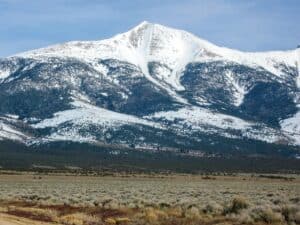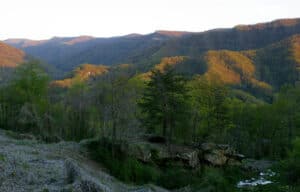If you’re planning a trip to the Cumberland River, you might be wondering, “Can we safely swim here?” The sun-kissed water of the Cumberland River winds its way through picturesque landscapes, inviting us to plunge into its cool embrace. But, is it safe? Is there a lot of pollution in its depths, or potentially dangerous wildlife? Let’s find out! But first, let’s explore a bit about the background of this famous American river. You might be surprised to learn about its historical significance!
What is the Cumberland River?
The Cumberland River is a significant watercourse flowing through the southeastern United States. The river’s history, which has its roots in the Appalachian Mountains, has altered the area it flows through.
Location and Length
The Cumberland River, which is 688 miles long, meanders through Tennessee and Kentucky before joining the Ohio River. Nearly 18,000 square miles of varied habitats and terrain make up its watershed.
Geographical Significance
From its origin in the Appalachian Mountains to its endpoint at the Ohio River’s confluence, the Cumberland River travels through a diverse landscape. The river provides vital water supplies for both human populations and animals as it travels through gorges, valleys, and plains.
Historical Significance
The history of the United States is not complete without mentioning the Cumberland River. Before European immigrants came, Native American cultures had lived along its banks for thousands of years. The river rose to prominence as a conduit for pioneers seeking westward migration in the late 18th century. It facilitated the expansion of settlements and commerce by offering a navigable route into the heart of the border.
Riverboats and Trade
The Cumberland River became a significant commerce route throughout the 19th century, particularly for riverboats carrying people and cargo. Cities like Paducah, Kentucky, and Nashville, Tennessee, prospered as river commerce centers, promoting regional economic growth.
Impact on Civil War
The Cumberland River held strategic importance during the American Civil War. It provided a transportation corridor for Union forces to advance into Confederate territory. The capture of Fort Henry and Fort Donelson along the river in 1862 marked significant victories for the Union, altering the trajectory of the war.
Modern Usage and Conservation
Today, the Cumberland River continues to serve as a vital water resource, supporting agriculture, industry, and recreational activities. The U.S. Army Corps of Engineers manages various dams along the river, which provide flood control, hydroelectric power, and water supply.
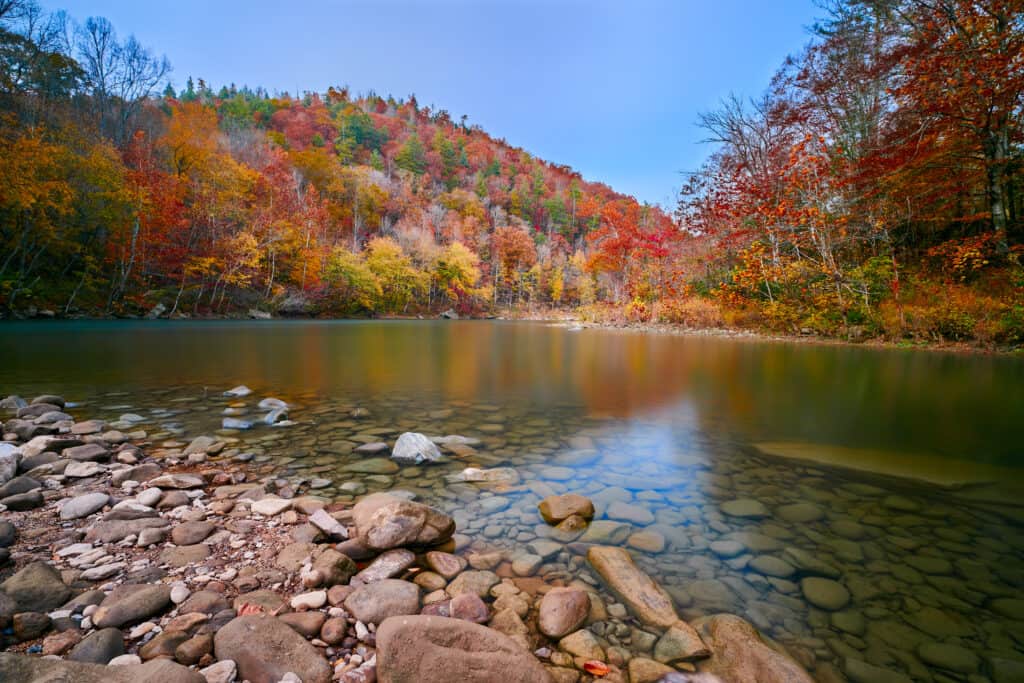
The Cumberland River is known for its natural beauty and wealth of activities, from swimming to fishing to boating.
©Patrick Jennings/Shutterstock.com
Is There Pollution in the Water of Cumberland River?
The Cumberland River has unfortunately not been immune to the challenges of pollution. Over the years, human activities have led to concerns about the water quality in this vital waterway.
Industrialization and Urbanization
As industries and cities grew along the Cumberland River’s banks, they brought with them a surge in pollution. Industrial effluents, untreated sewage, and runoff from urban areas have contributed to the river’s pollution load. These contaminants can include chemicals, heavy metals, and nutrients, posing potential risks to both aquatic life and human health.
Agricultural Runoff
Agricultural practices in the Cumberland River’s watershed have also contributed to water pollution. Excess nutrients from fertilizers can wash into the river, leading to nutrient imbalances in the water. This, in turn, can fuel the growth of harmful algae blooms, which can negatively impact aquatic ecosystems and water quality.
Impact on Aquatic Life
Pollution in the Cumberland River can have detrimental effects on its aquatic inhabitants. Fish and other aquatic organisms may be exposed to toxins, which can lead to reduced populations and biodiversity. The presence of pollutants can also degrade habitats and disrupt the natural balance of the river’s ecosystem.
Human Health Concerns
Pollution in the Cumberland River raises concerns for human health as well. Contaminants can find their way into drinking water supplies, potentially affecting the health of communities downstream. Moreover, recreational activities such as swimming and fishing might pose health risks if the water is contaminated.
Conservation and Mitigation Efforts
Efforts have been made to address pollution in the Cumberland River. Regulatory agencies and local organizations work to monitor water quality, establish pollution limits, and enforce regulations. Additionally, initiatives to reduce industrial discharges and improve wastewater treatment have been implemented to mitigate pollution sources.
Public Awareness and Engagement
Raising public awareness about the importance of preserving the Cumberland River’s water quality is crucial. Education campaigns and community involvement help foster a sense of responsibility among residents, encouraging sustainable practices and reducing pollution at its source.
Potentially Dangerous Animals in the Cumberland River
The Cumberland River is home to a diverse array of wildlife, but among the natural inhabitants are certain species that can pose risks to humans. While the majority of these creatures prefer to avoid interaction, it’s important to be aware of potential hazards when enjoying the outdoors near the river.
Venomous Snakes
Several species of venomous snakes call the Cumberland River region home, including the copperhead and timber rattlesnake. These snakes are reclusive by nature and will generally avoid human contact. However, if accidentally provoked or cornered, they may defend themselves with a bite that delivers venom. Caution and awareness while hiking or exploring snake habitats are essential to minimize the risk of encounters.

Copperheads are common along the river, but they avoid humans as much as possible. As always, exercise caution if you happen to discover one, and do not touch it.
©outdoorsman/Shutterstock.com
Aquatic Concerns
Within the river itself, certain fish species can present dangers. The longnose gar, recognized by its elongated snout and sharp teeth, can potentially cause harm if handled improperly. Similarly, the freshwater drum, while not usually aggressive, possesses powerful teeth that can deliver painful bites. When handling or releasing fish, exercising care and employing proper techniques is advisable.
Insects and Arachnids
Insects and arachnids found in the Cumberland River area can also pose minor risks. The black widow spider, characterized by its red hourglass-shaped marking, carries a venom that, while rarely fatal, can cause discomfort and health issues. Just as well, ticks that thrive in wooded and grassy areas can transmit diseases, highlighting the importance of using appropriate clothing and repellents.
Safety Measures
To mitigate potential risks from these creatures, adopting certain safety measures is recommended. When hiking, wear sturdy footwear and be cautious when stepping over rocks or logs to avoid disturbing snakes. In aquatic settings, handle fish with care and avoid touching unfamiliar species. For insects and arachnids, taking precautions such as wearing long sleeves and using insect repellents can minimize encounters.
Educational Awareness
Understanding the behaviors and habitats of potentially hazardous creatures is essential for safe interaction with the natural world. Educational resources and local wildlife experts can provide valuable insights into recognizing and respecting these creatures from a safe distance.
Is It Safe to Swim in the Cumberland River?
The Cumberland River’s allure extends beyond its scenic beauty, prompting questions about the safety of swimming in its waters. To put it simply, the river is safe to swim in. But while the river offers various recreational opportunities, it’s important to consider factors that impact the safety of swimming activities.
Water Quality and Currents
The Cumberland River’s water quality can vary based on factors such as rainfall, pollution, and seasonal changes. Rapid changes in water levels and currents can pose risks to swimmers, especially those unaware of potential hazards. It’s advisable to check local advisories and research the current conditions before swimming.
Designated Swimming Areas
Some areas along the Cumberland River are designated as safe for swimming. These locations often have lifeguards on duty, proper signage, and amenities to ensure a safer experience. Sticking to these designated swimming areas can minimize risks associated with unpredictable currents and unfamiliar terrain.
Hazards and Underwater Obstacles
While the Cumberland River offers inviting stretches of water, it’s important to be mindful of potential hazards beneath the surface. Submerged rocks, debris, and other obstacles may not be immediately visible, making it essential to exercise caution and enter the water cautiously.
Weather Conditions
Weather conditions can play a significant role in the safety of swimming in the Cumberland River. Thunderstorms, strong winds, and changing weather patterns can quickly alter water conditions and increase the risk of accidents. Monitoring weather forecasts and heeding advisories is crucial before planning any water activities.
Personal Swimming Abilities
Individual swimming abilities should also be considered. The Cumberland River’s currents and depths can be challenging for swimmers who are not confident in their skills. It’s important to accurately assess your swimming capabilities and never venture into areas that exceed your comfort level.
Children and Supervision
If planning to swim with children, proper supervision is paramount. Children should always wear appropriate flotation devices, and parents or guardians should be vigilant at all times. Educating children about water safety and the potential risks of swimming in natural bodies of water is essential.
Wildlife Considerations
The Cumberland River’s aquatic environment is home to various wildlife species. While encounters are generally rare, some animals could pose minor risks. Being informed about local wildlife and their behaviors can help swimmers navigate potential interactions safely.
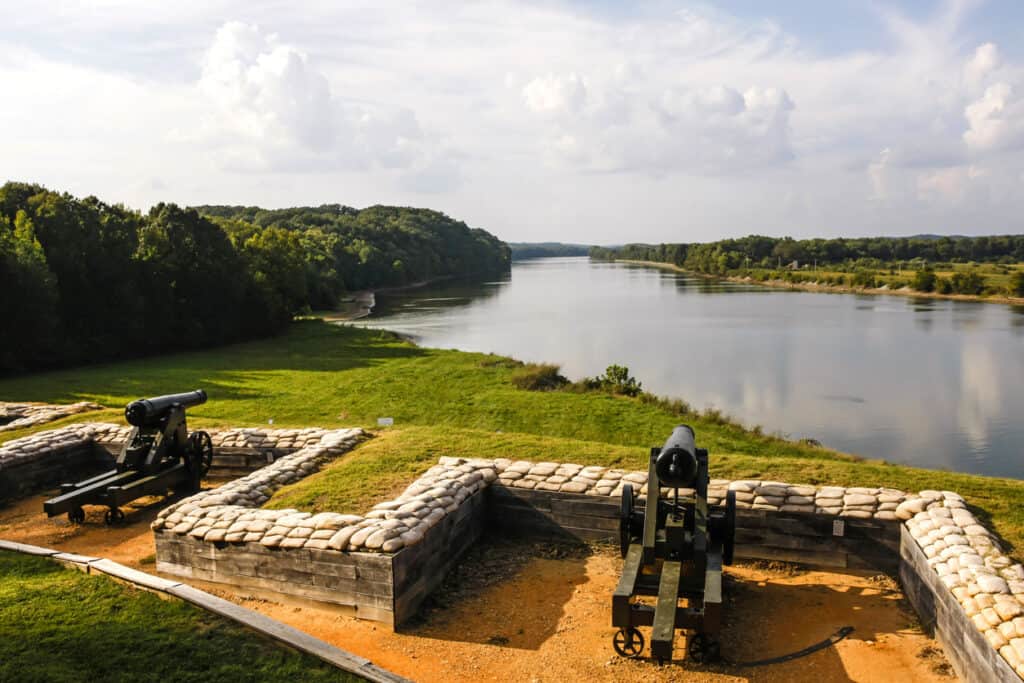
It’s vital to respect local wildlife and safety precautions when enjoying tourism around Cumberland River, for the sake of the wildlife as well as your own!
©iStock.com/csfotoimages
Other Wildlife Found in and Around the Cumberland River
The Cumberland River is a thriving ecosystem, home to a wide variety of wildlife species that have adapted to its diverse landscapes. From the river’s waters to the surrounding woodlands, this region supports an array of creatures that contribute to its rich ecological tapestry.
Avian Abundance
The Cumberland River and its surrounding wetlands provide crucial habitats for numerous bird species. Majestic bald eagles can be spotted soaring through the skies, while great blue herons and ospreys can be observed hunting for fish along the riverbanks. During seasonal migrations, flocks of ducks and geese make the river a temporary haven, adding to its avian diversity.
Aquatic Wonders
Within the river’s waters, a vibrant array of aquatic life thrives. Various fish species, such as bass, catfish, and sunfish, inhabit these waters, contributing to the river’s fishing allure. Otters, known for their playful behaviors, frolic in the river’s currents, while beavers construct their lodges along its banks.
Mammals of the Forest
The woodlands flanking the Cumberland River are inhabited by an assortment of mammals. White-tailed deer are a common sight, gracefully navigating the underbrush. Raccoons and opossums, well adapted to urban environments, can also be found foraging for food at night. Coyotes, secretive by nature, occasionally make appearances, showcasing the region’s diverse mammalian inhabitants.
Amphibians and Reptiles
The river’s riparian zones and wetlands provide ideal habitats for amphibians and reptiles. Frogs and toads fill the air with their calls during rainy nights, contributing to the soundscape of the region. Slender water snakes and elegant turtles, such as the painted turtle, can often be seen sunbathing along the river’s edges.
Activities to Enjoy on the Cumberland River
The Cumberland River has some serious majestic scenic beauty and diverse landscapes. The river also offers a wealth of recreational opportunities for visitors to enjoy. From water-based activities to land adventures, this river is a playground for outdoor enthusiasts seeking memorable experiences.
Fishing
The Cumberland River is a paradise for anglers. With its rich aquatic life, including bass, catfish, and trout, fishing enthusiasts have ample opportunities to cast their lines. Whether from the banks or a boat, the river’s tranquil waters promise an unforgettable fishing experience.
Canoeing and Kayaking
For those seeking a more immersive river encounter, canoeing, and kayaking provide a unique perspective. Paddling along the river’s meandering course allows adventurers to admire the lush scenery, spot wildlife, and explore hidden coves and inlets.
Riverboat Tours
Embrace the spirit of history by embarking on a riverboat tour along the Cumberland. Guided tours provide insights into the region’s past, allowing visitors to envision the river’s role in trade, transportation, and the growth of nearby communities.
Hiking Trails
The river’s surroundings are adorned with hiking trails that cater to various skill levels. From strolls to challenging hikes, these trails offer opportunities to connect with nature while absorbing breathtaking vistas of the Cumberland River and its valley.
Picnicking and Camping
Several parks and green spaces along the riverbanks are perfect for picnics and outdoor gatherings. For those seeking an extended rendezvous with nature, campgrounds are available, allowing visitors to immerse themselves in the river’s serenity under starlit skies.
Wildlife Observation
The Cumberland River’s diverse ecosystem beckons wildlife enthusiasts and birdwatchers. Equipped with binoculars, visitors can spot a myriad of avian species, observe amphibians in their natural habitats, and perhaps catch a glimpse of elusive mammals.
Rock Climbing
Adventure seekers can find their thrill by engaging in rock climbing activities along the Cumberland River. With a variety of climbing routes suitable for different skill levels, climbers can challenge themselves while enjoying stunning views.
Zip-lining and Canopy Tours
For those who crave an adrenaline rush, zip-lining, and canopy tours provide an exhilarating way to view the Cumberland River from above. Soar through the treetops and enjoy panoramic vistas of the river and its scenic surroundings.
The Cumberland River is a canvas of possibilities, inviting visitors to partake in an array of activities that cater to diverse interests. From fishing and kayaking on its waters to hiking its trails and observing its wildlife, the river’s offerings are as varied as the landscapes it traverses. By engaging responsibly and embracing the river’s wonders, visitors can create lasting memories while contributing to the conservation of this natural treasure. And, luckily, the river is quite safe to swim in!
The photo featured at the top of this post is © Sean Pavone/Shutterstock.com
Thank you for reading! Have some feedback for us? Contact the AZ Animals editorial team.




